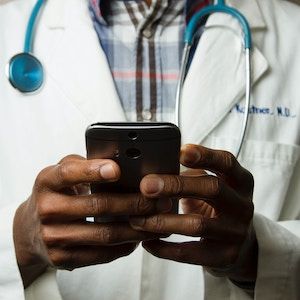Article
Hybrid Care During COVID-19 Benefited Glycemic Control in Older Adults with T1D
Author(s):
A combination of in-office and telehealth visits increased visit frequency and maintained glycemic control in older adults with T1D during the COVID-19 pandemic.
Credit: National Cancer Institute/Unsplash

Hybrid care during the COVID-19 pandemic, consisting of telehealth plus in-person visits, allowed for increased visit frequency and preserved hemoglobin A1c values in older adults with type 1 diabetes (T1D), compared with a pre-pandemic care model.1
The findings, presented at the 83rd Scientific Sessions of the American Diabetes Association (ADA 2023), suggest the hybrid care model favorable increased the proportion of patients with HbA1c <7% with decreasing proportion at the higher end of the distribution.
“The data demonstrates that the hybrid care model, combining in-office and telemedicine, was effective in increasing visit frequency and maintaining glycemic control in older adult with T1D during the COVID-19 pandemic,” wrote the investigative team, led by Atif Adam, PhD, MBBS, a research fellow in medicine at Joslin Diabetes Center.
Older adults with T1D often face challenges in managing their condition, due to aging, intensive insulin therapy requirements, and psychosocial barriers.2 Telemedicine may be an alternative to in-person visits and could expand access to healthcare, particularly for this population. The onset of the COVID-19 pandemic and its resulting lockdown provided an opportunity to evaluate the impact of hybrid care on clinical visit frequency and glycemic outcomes, compared to in-person only care.
Within the current retrospective analysis, investigators examined electronic health records to assess the impact of hybrid care among adults aged ≥65 years with T1D and receipt of ≥1 insulin prescriptions.1 The team examined how the use of hybrid care impacted the frequency of clinical visits and glycemic control in this patient cohort. Electronic health records were used to retrieve patient demographics, clinical characteristics, visit logs, and HbA1c measurements covering 2 time periods with adjustments for length of follow-up: pre-pandemic (April 2019 - March 2020) and pandemic (September 2020 - August 2021).
For the analysis, investigators used descriptive statistics to summarize demographic and clinical characteristics. A paired t-test was used to compare mean HbA1c levels, and a chi-square test was used to compare the distribution of HbA1c levels (≤7%, 7–8%, >8%) between the 2 study periods. Additionally, a Poisson regression model was used to compare the rate of clinical visits between the 2 periods, adjusting for potential confounders.
A total of 661 (45% male) unique older adults with T1D received care and HbA1c measurement in both periods at a tertiary diabetes center. The population had a mean age of 72 ± 5 years, with 59% being continuous glucose monitor (CGM) users and 38% being pump users.
In the pre-pandemic period, clinic visits were almost all in-person, with an average of 4.2 visits per person-year (95% CI, 3.9 - 4.4), with <2% as phone visits. The analysis then showed the mean number of visits was significantly greater in the pandemic period, at 6.3 visits per person-year (95% CI, 5.7 - 6.9) with 30% in-office, 38% by video, and 32% by phone. Investigators noted HbA1c values were similar between the pre-pandemic (7.6%; 95% CI, 7.5 - 7.8) and pandemic periods (7.4%; 95% CI, 7.3 - 7.6).
The analysis revealed a significant, favorable shift in HbA1c distribution (<7%, 7 - 8%, >8%) when using a hybrid care model. In the pre-pandemic period, the HbA1c levels were 21%, 42%, and 37%, respectively. In the pandemic, the HbA1c levels were 35%, 36%, and 29%, respectively (pre-pandemic vs. pandemic period, P <.001).
“Our data supports the continued integration of telemedicine into the care model for this population,” investigators wrote.
References
- Adam A, Munshi M, Hurlbert R, Slyne C, Laffel L, Toschi E. Success of a Hybrid Care Model to Maintain Glycemic Control in Older Adults with Type 1 Diabetes. Poster presentation at the 83rd Scientific Sessions of the American Diabetes Association. June 23 – 26, 2023
- Dhaliwal R, Weinstock RS. Management of Type 1 Diabetes in Older Adults. Diabetes Spectr. 2014;27(1):9-20. doi:10.2337/diaspect.27.1.9





